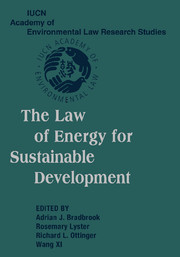Book contents
- Frontmatter
- Contents
- Acknowledgments
- Message from Kofi A. Annan, Secretary-General, United Nations
- Introduction – A Global Learned Society to Address Earth's Evolution: The IUCN Academy of Environmental Law
- Public Lectures on International Environmental Law
- PART ONE SUSTAINABLE DEVELOPMENT AND THE ROLE OF ENERGY LAW
- PART TWO LEGAL ISSUES IN CONTEMPORARY ENERGY LAW
- PART THREE INTERNATIONAL ENERGY LAW
- PART FOUR COMPARATIVE ENERGY LAW
- PART FIVE ELECTRICITY RESTRUCTURING
- 24 Some Environmental Lessons from Electricity Restructuring
- 25 The Implications of Electricity Restructuring for a Sustainable Energy Framework: What's Law Got to Do with It?
- 26 Electricity Market Liberalization and Energy Sustainability
- PART SIX FINANCING FOR SUSTAINABLE ENERGY
- PART SEVEN CIVIL SOCIETY AND THE PROCEDURAL REQUIREMENTS OF ENERGY LAW FOR SUSTAINABLE DEVELOPMENT
- Index
26 - Electricity Market Liberalization and Energy Sustainability
Published online by Cambridge University Press: 10 August 2009
- Frontmatter
- Contents
- Acknowledgments
- Message from Kofi A. Annan, Secretary-General, United Nations
- Introduction – A Global Learned Society to Address Earth's Evolution: The IUCN Academy of Environmental Law
- Public Lectures on International Environmental Law
- PART ONE SUSTAINABLE DEVELOPMENT AND THE ROLE OF ENERGY LAW
- PART TWO LEGAL ISSUES IN CONTEMPORARY ENERGY LAW
- PART THREE INTERNATIONAL ENERGY LAW
- PART FOUR COMPARATIVE ENERGY LAW
- PART FIVE ELECTRICITY RESTRUCTURING
- 24 Some Environmental Lessons from Electricity Restructuring
- 25 The Implications of Electricity Restructuring for a Sustainable Energy Framework: What's Law Got to Do with It?
- 26 Electricity Market Liberalization and Energy Sustainability
- PART SIX FINANCING FOR SUSTAINABLE ENERGY
- PART SEVEN CIVIL SOCIETY AND THE PROCEDURAL REQUIREMENTS OF ENERGY LAW FOR SUSTAINABLE DEVELOPMENT
- Index
Summary
INTRODUCTION
Many countries have adopted a market approach to the reform of their electricity industries. Whether such changes help or hinder energy sustainability is debatable. Do they contribute to energy efficiency and conservation, and the uptake of renewable energy? This chapter examines the inherent characteristics of a market approach in comparison with a political or regulatory approach, for example in relation to energy pricing and investment. The role of subsidies is considered. It examines the legal design of energy market institutions and the manner in which the details of market design can affect energy sustainability, such as in demand-side management. It appraises policy instruments grafted onto a market strategy in order to improve energy sustainability. It concludes that, while the record is mixed, a market approach can make a contribution to energy sustainability.
ENERGY SUSTAINABILITY
Three elements can be identified in energy sustainability. Energy efficiency concerns the productivity we obtain from the primary energy we consume. Although in technical terms some energy is always wasted when it is converted from one form to another, or put to use, the amount can be reduced. Improvements in energy efficiency mean that the amount of economic output or satisfaction of human needs per unit of energy can be increased. Some countries, like Japan, have made dramatic improvements in the measure of gross domestic product obtained per unit of energy consumed. The second element, energy conservation, is the reduction of energy use, for example in eliminating unnecessary heating.
- Type
- Chapter
- Information
- The Law of Energy for Sustainable Development , pp. 449 - 470Publisher: Cambridge University PressPrint publication year: 2005



